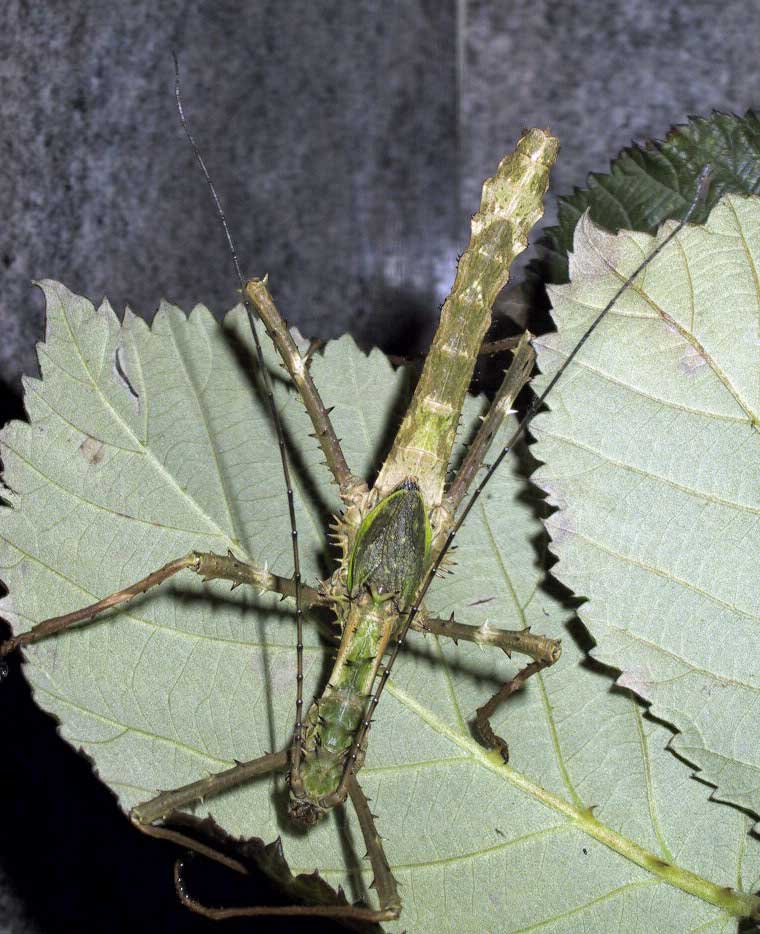
Haaniella erringtoniae (*)
Superregnum: Eukaryota
Cladus: Unikonta
Cladus: Opisthokonta
Cladus: Holozoa
Regnum: Animalia
Subregnum: Eumetazoa
Cladus: Bilateria
Cladus: Nephrozoa
Cladus: Protostomia
Cladus: Ecdysozoa
Cladus: Panarthropoda
Phylum: Arthropoda
Subphylum: Hexapoda
Classis: Insecta
Cladus: Dicondylia
Subclassis: Pterygota
Cladus: Metapterygota
Infraclassis: Neoptera
Supercohort: Polyneoptera
Cohort: Anartioptera
Magnordo: Polyorthoptera
Superordo: Orthopterida
Ordo: Phasmatodea
Subordo: Verophasmatodea
Infraordo: Areolatae
Superfamilia: Bacilloidea
Familia: Heteropterygidae
Subfamilia: Heteropteryginae
Tribus: Heteropterygini
Genus: Haaniella
Species: Haaniella erringtoniae
Name
Haaniella erringtoniae (Redtenbacher, 1906)
References
Paul D. Brock 2018: Phasmida Species File (Version 5.0/5.0) [1]
Hennemann, F.H., Conle, O.V., Brock, P.D. & Seow-Choen, F. 2016. Revision of the Oriental subfamily Heteropteryginae Kirby, 1896, with a re-arrangement of the family Heteropterygidae and the descriptions of five new species of Haaniella Kirby, 1904. (Phasmatodea: Areolatae: Heteropterygidae). Zootaxa 4159(1): 1–219. DOI: 10.11646/zootaxa.4159.1.1 Reference page.
For more multimedia, look at Haaniella erringtoniae on Wikimedia Commons.
Vernacular names
English: Errington’s Haaniella
Haaniella erringtoniae is a stick insect species. It is a typical representative of the subfamily Heteropteryginae. The occasionally used common name Errington's Haaniella refers to the species name.[1]
Description
Both sexes are armed with many spines on the body and legs. Fore and hind wings are greatly shortened. The sexual dimorphism typical of stick insects is also very pronounced in this species. The slimmer, little patterned to monochrome males are gray-brown to greenish in color and are about 65 to 80 millimetres (2.6 to 3.1 in) long. The bright green front edges of the thickened, only 10 millimetres (0.39 in) long front wings, which are here developed as tegmina, are striking. The bigger females reach a length of 85 to 110 millimetres (3.3 to 4.3 in).[2] They are reddish-brown and beige, or occasionally a light pink piebald. Typical are the light-colored bandages on the femurs and two rows of white dots on the ventral abdomen. The for Heteropterygini species typical secondary ovipositor is beak-shaped.[3]
Distribution and way of life
The species is native to Malesia more precisely on the Malay Peninsula. The animals found in the west of the island Sumatra are Haaniella muelleri.[4][5][6]
During the day the insects hide in the leafy layer of the forest floor, where they are very well camouflaged due to their color and body shape. Do not climb until dusk they hit trees and bushes to eat the leaves. In the event of danger, both sexes are able to produce rustling noises with their wings (stridulation). In addition, the animals then threaten the attacker with the abdomen raised and the hind legs splayed upwards. When approaching further, the tibae of the hind legs are quickly struck against the femurs, making the spines on them very effective weapons of defense.[3][4]
Reproduction
The females lay their eggs a few centimeters deep in the ground with the laying stinger. With a length of about 6.5 millimetres (0.26 in) and a width of 5.5 millimetres (0.22 in), these are not even particularly large compared to the eggs of other representatives of this genus. In contrast to most of other Haaniella species, they are not rough and bristled, but smooth and hairless, like the lemon-shaped eggs of Haaniella saussurei.[2] The cruciform micropylar plate with the clearly visible micropyle in the lower corner of the cross is striking. The life cycle of Haaniella erringtoniae is shorter in each phase than that of most of other Haaniella species, like those known from Borneo. After only six months, the first nymphs hatch from the eggs, which are often already adult after a further six months.[3]
Taxonomy
The species was described in 1906 by Josef Redtenbacher as Heteropteryx erringtoniae. He chose the specific epithet in honor of her discoverer Madam Errington.[7] After the species was first transferred to the genus Haaniella, introduced Klaus Günther in 1944 as a subspecies to Haaniella muelleri. Since 1995 it was even understood as synonym of this species.
A female was deposited in the Muséum national d'histoire naturelle as holotype.[1] The species has been recognized as a valid species again since 2016.[6]
In terraristics
The specimens introduced in the early 1990s from the Templar Park in Malay Perak were initially distributed under the name Haaniella muelleri in terrariums. Only the comparison with the type specimens showed that the specimens kept are Haaniella erringtoniae. All publications about this insects in breeding up to 2009 refer to Haaniella erringtoniae.[4][5]
The species prefers temperatures of 22 to 27 °C (72 to 81 °F) and high humidity. In the terrarium they can easily be fed with oak and bramble leaves. A slightly moist substrate is required to lay eggs, which should cover the floor of the terrarium 5 to 10 centimetres (2.0 to 3.9 in) high.
Haniella erringtoniae is listed under PSG number 112 by the Phasmid Study Group.[8]
References
Brock, P. D.; Büscher, T. H. & Baker, E. W. Phasmida Species File Online. Version 5.0. (accessdate 28 August 2021)
Zompro (2000). Gespenstheuschrecken der Familie Heteropterygidae im Terrarium, Reptilia – Terraristik Fachmagazin, Nr. 24, August/September, Natur und Tier, Münster.
Seiler, C.; Bradler, S & Koch, R. (2000). Phasmiden – Pflege und Zucht von Gespenstschrecken, Stabschrecken und Wandelnden Blättern im Terrarium. bede, Ruhmannsfelden, ISBN 3-933646-89-8
Bäthe, R.; Bäthe, A. & Fuß, M. (2009). Phasmiden, Schüling Verlag, Münster, S. 134–137, ISBN 978-3-86523-073-7
Haaniella erringtoniae on phasmatodea.com by Hennemann, F. H.; Conle, O. V.; Kneubühler, B. & Valero, P.
Hennemann, F. H.; Conle, O. V.; Brock, P. D. & Seow-Choen, F. (2016). Revision of the Oriental subfamiliy Heteropteryginae Kirby, 1896, with a re-arrangement of the family Heteropterygidae and the descriptions of five new species of Haaniella Kirby, 1904. (Phasmatodea: Areolatae: Heteropterygidae), Zootaxa 4159 (1), Magnolia Press, Auckland, New Zealand, ISSN 1175-5326
Josef Redtenbacher (1906). Die Insektenfamilie der Phasmiden. Vol. 1. Phasmidae Areolatae. Verlag Wilhelm Engelmann, Leipzig, pp. 169–170
Phasmid Study Group Culture List
Retrieved from "http://en.wikipedia.org/"
All text is available under the terms of the GNU Free Documentation License

